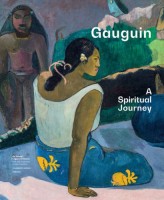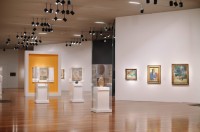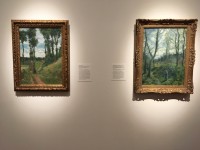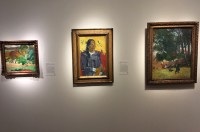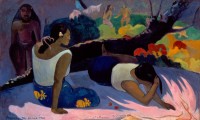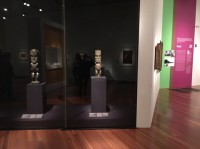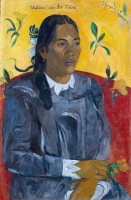The browser will either open the file, download it, or display a dialog.
Gauguin: A Spiritual Journey
deYoung Museum, Fine Arts Museums of San Francisco, CA
November 17, 2018–June 23, 2019
Catalogue:
Christina Hellmich and Line Clausen Pedersen, with contributions by Elizabeth C. Childs, Carol S. Ivory, Théano Jaillet, Yuki Kihara, Philippe Peltier, Agnès Penot, Léa Saint-Raymond, and Belinda Thompson,
Gauguin: A Spiritual Journey.
San Francisco: FAMSF, 2018.
256 pp.; 227 color illus.; bibliography pp. 244–46; index pp. 246–253.
$60 (hardcover)
ISBN: 978-3-7913-5795 9
Gauguin: A Spiritual Journey brings together highlights from the collections of the Fine Arts Museums of San Francisco (FAMSF) and the Ny Carlsberg Glyptotek in Copenhagen. The show presents itself as exploring two main themes: Gauguin’s search for spiritual meaning, and (to quote the introductory panel), “the intimate relationships and professional friendships that shaped his life and work.” It also shows Gauguin’s works alongside objects that come from the Pacific Islands where Gauguin spent most of the last decade of his life. Because his responses to the belief systems that he encountered in his travels raise unsettling aspects of his career—his appropriations, his primitivism, his purposeful misrepresentation of the cultures he moved around in—I walked into the exhibition with a very specific question in mind: how, at this cultural moment, would the curators present Gauguin’s spirituality in a way that would be both accessible to a general audience and sensitive to the problems it highlights?
This, as it turned out, was not the right question. While the exhibition certainly does cover Gauguin’s travels, “spirituality” turned out not to be at all central. When the term itself comes up in any of the didactic material in the galleries, it feels incidental or so vague as to be nearly meaningless, and the idea certainly does not unify or give a sense of focused development to the experience of the show itself.[1] And neither does the other theme presented as central, Gauguin’s “intimate relationships and professional friendships.” We do learn about Gauguin’s wife and other people who supported him throughout his career, but we do not get as much of a sense of them in their roles as intimates or friends. What, then, connects all of the different parts of this exhibition? Nothing, really—the show is fragmented, with a number of occasionally converging but often stubbornly parallel themes running through it. And while I was initially disconcerted, by the end of the exhibition I had come to think of that fragmentation as one of its strengths. Rather than being organized around a grand unifying theory about spirituality in Gauguin’s career, this exhibition instead seems driven by many different laudable ambitions on the part of its various curators and contributors. These ambitions do not all come together neatly, nor are all of them thoroughly realized—and opportunities are definitely, and sometimes confoundingly, missed. But the exhibition does invite the viewers to think less about general and potentially reductive themes, and to wrestle instead with some more complex, specific and grounded questions. It also creates the opportunity for viewers to feel ambivalent about Gauguin as a historical figure. But because the show bills itself misleadingly and clings to a larger vision that is not consonant with its actual accomplishments—or, often, with its actual artworks—I suspect that many visitors’ confusion will make it hard for them to be receptive to the stories it tells.
The exhibition is unambiguously ordered according to chronology: a good choice, as it provides a clear and accessible organizing principle to counterbalance its plurality of ideas. The space itself is very open, with no absolute physical breaks between different parts; partitions are used more to direct viewers along a particular path than to create separate and discrete galleries. The viewer’s experience flows accordingly from moment to moment, and this flow encourages them to make thematic connections throughout the entire show. There is nonetheless a clear shift in the exhibition’s focus halfway through, that coincides with the year 1891 and Gauguin’s initial trip to Tahiti. The first half winds around through fairly narrow spaces, so that the intended order from one artwork to the next is very clear: we are focused here on Gauguin’s stylistic development, and his path from stockbroker and Sunday painter to fully committed artist. The second opens into a larger, and largely unpartitioned, space (fig. 1), in which the visitor can move about more freely—and the transition between these two halves is marked by the first of the exhibition’s artworks from the Pacific Islands, a possibly precolonial Tahitian volcanic stone ti’i (figure). It is this figure that most clearly tells the viewer that they have moved into a new stage of the exhibition, one that expands beyond Gauguin’s career to consider examples of art from Tahiti, New Zealand, and the Marquesas.
Once past the opening text panel, the first artwork that the viewer encounters is a tiny portrait of Mette Gauguin, made by her husband in the brief halcyon days of their courtship and early marriage. The quotation from Gauguin that accompanies this tender sketch drips with irony for anyone who knows something of his life: “Rest assured that in carrying off from Denmark so precious a pearl, I will do everything possible, and even impossible, so that she will not regret leaving her friends. . . .” This work is the only depiction of Mette shown, but its prominent placement foretells the important roles she will play here. What we learn of her transforms Mette from a symbol of betrayed womanhood and Gauguin’s repudiation of domesticity into an individual who was shrewd, determined, and loyal beyond what anyone could possibly have expected. We learn that many of the artworks from the Ny Carlsberg Glyptotek had belonged to her husband and then to her, that she had managed his career and his collection, had promoted him in Copenhagen, had maintained an extensive correspondence on his behalf, and had supported herself and her five children. Mette has long been a sidelined character in Gauguin’s story, but this exhibition makes a powerful case that she should be oversimplified and overlooked no longer.[2]
Mette is therefore a key player also in establishing one of the most central and consistently revisited leitmotifs of this exhibition: money. In fact, almost every relationship presented in this first half of the exhibition is explored from the perspective of economics. For example, early on we see Pissarro’s Landscape from the Pontoise Area (1878) paired with Gauguin’s Landscape with Tall Trees (1883) to establish Gauguin’s naturalistic roots; the pairing helps to highlight both Gauguin’s close attention to the specifics of the scene and the stuttered, impressionistic brushstrokes of his early paintings (fig. 2). But we also learn about how Pissarro connected him to patrons, and how the Pissarro paintings that Gauguin acquired at this time were later sold by Mette to help maintain her husband. And the focus on the financial is equally intense in the second half of the show, as we will see. This whole exhibition benefits tremendously from the organizers’ engagement with the question of money and the market, and this theme might have provided a throughline for the show. It is explored in a majority of the more in-depth didactic panels that accompany individual artworks, and helps to organize the biographical aspect of the story. Perhaps the phrase in the introductory panel that proclaims the intention to present “professional friendships that shaped his life and work” can best be understood as a euphemism for how Gauguin financed his life and career, and tried to accommodate the pressures of the market. This last theme might have given greater cohesion to this show, especially as the contributors foregrounded the role of the European art market not only in Gauguin’s career, but also in developments of the arts of Tahiti, the Marquesas, and the rest of the Pacific region over the course of the colonial encounter. Was this goal considered to be too baldly material for a “spiritual” show? Whatever lay behind that decision, the serious engagement with the complexities of funding an unconventional artistic career, established right out of the gate, pays off all the way through to the end.
The exhibition then proceeds to one of Gauguin’s peripatetic phases, which encompasses his trips to Panama and Martinique, Brittany and Arles. The logistics of his journeys—where he stayed and produced artwork, how he traveled—are all laid out in extensive wall texts that the visitor encounters literally around every corner. The entire exhibition is positively bristling with didactic material, which is why this review has thus far focused more on the show’s themes, as opposed to the objects in it. The nigh-on-omnipresence of these materials highlights one of the great strains in the show’s conception: the actual objects to which the curators had access weren’t quite compatible with, and could not always support the weight of, their ambitions. Nowhere is this more true than in the section under consideration. An extensive wall text illuminates Gauguin’s time in Brittany and Arles, and his collaborations with both Emile Bernard and van Gogh. Neither of those artists’ works are displayed here, and while there are a few compositions from Gauguin’s stints in Brittany, his stay in Arles is represented only by a sketch. Another large panel addresses the importance of the Volpini suite published by Ambroise Vollard, but it is seen only in one reproduction. The products of these relationships, so central to the canonical story of Gauguin’s importance to the development of modernism, are simply not the strengths of either of the collections contributing here, and the choice to emphasize them strikes me as very strange. These transitional, generative, and compelling years do of course have to be represented in a show that encompasses Gauguin’s whole career—and they are—but by lesser-known aspects of his output rather than the canonical paintings and prints for whose absence this section appears to be trying to compensate. The true stars of this part of the show are the approximately fifteen examples of Gauguin’s early forays into ceramics. A panel discusses Gauguin’s introduction to this medium, where he made them, and what broad themes inspired him, but unlike the more aesthetically approachable and familiar paintings in the previous section, which are accompanied by a clearly articulated story and numerous, extensive wall labels, these strange experiments are left almost entirely to speak for themselves. Also included here is a series of zincographs from the FAMSF’s collection that juxtaposes aspects of different parts of the world. This characteristic of Gauguin’s work is highlighted by interpretive texts elsewhere in the exhibition, but is completely unremarked upon here. These physically present objects are overshadowed by a well-established art historical narrative that they do not tell.
What do these ceramics and prints suggest in their relatively unmediated presentation? First and foremost, they testify to the centrality of the female figure in Gauguin’s syncretic experiments. While the texts on the walls refer to “communities,” “narratives,” and “figurative subjects,” they seldom mention a more obvious subject: endless permutations of the female form. The bodies on the ceramics are at times compacted, at times spread, and at all points manhandled, squished onto muddy surfaces and accompanied by beasts and food.[3] The prints are populated by heavily contoured, torturously posed women placed in evocative landscapes and surrounded by beasts and food. The wooden reliefs included here have the same imagery. While the bold cloissonist beauty of many of the paintings from this period, absent from this exhibition, distract from the bald brutality of these acts of manipulation, the objects we see here cannot help but raise questions about gender and Gauguin’s problematic use of the female body that have preoccupied scholars for decades. These questions are not directly addressed here—and this neglect is particularly confusing given aspects of the exhibition still to be discussed.
From this low point in the show, we move to one of the highest: the beginning of Gauguin’s much anticipated engagement with the cultures of the Pacific Islands. This is where the exhibition space opens up and greets the viewer with the ti’i sculpture and, to its right, a wall with three paintings side by side (fig. 3). These compositions from 1891 to 1893, all of Tahitian subjects and quite remarkably different from each other, work together with the accompanying texts to present a profound and cohesive narrative about Gauguin’s career in this new place.
The first (the installation encourages the viewer to experience them from right to left), with its vertical composition, screen of trees that strategically reveals houses, quotidian activity in the foreground, and quick, impressionistic brushwork, resonates with paintings seen earlier that showcased Gauguin’s play with naturalism; a viewer can look over their shoulder and glimpse those paintings—too far to see in detail, but clear enough to spark memory—through a gap between two partitions. The tombstone information for this work (“Landscape from Tahiti with four Figures, [1891] . . . probably Mataiea on the south coast;” one of the catalogue essays theorizes that it depicts Gauguin’s hut) shows that the iconography permits an identification of the location.[4] The effort at accuracy and description here, and a representation of subject matter that would appeal to potential buyers with ethnographic interests, strikingly contrasts with Tahitian Woman with a Flower (1891)—one of the highlights of the exhibition, and one of the best examples in all of Gauguin’s career of some of his strengths as an artist: here, he created a balance of flat decorativeness and convincing physical presence, and a synergy of abstract formal power and profound expressiveness. However, the didactic text for this painting informs the viewer that the painting was partly inspired by desires to appeal to the Parisian market. Even in the face of one of the most sumptuous paintings in the show, the viewer is not allowed to impute to Gauguin some kind of purity of vision beyond worldly pressures. The third painting diverges from both of the others. Like the first, it is a landscape, but its more horizontal composition, stronger contours, longer brushstrokes, and more abstracted forms echo the synthetist paintings from Brittany more recently encountered. Its wall text, like that for Tahitian Woman with a Flower, also explicitly reminds us that Gauguin created “many . . . landscapes in the Pacific with the Paris market in mind.” We have been faced all along with evidence of the artist’s subjection to the caprices of the market, and we are immediately informed that this concern did not cease to be important after he had fled Europe. Any formal generalization a viewer might have been tempted to make about paintings of Tahiti is foreclosed by this grouping—and it also tempers any desire to romanticize Gauguin’s relationship to the places and the people depicted in his art.
Beyond this wall, we enter a space that brings together work Gauguin created in Tahiti and the Marquesas with twelve objects produced by indigenous artists. Most of the latter are from New Zealand and the Marquesas. Brought together and mediated as they are in this show, they tell the story of an insidious European desire for “primitive” artworks. We are told that traditional forms were made smaller because they were easier to sell in curio shops, that the tourist trade transformed the making of previously predominantly practical objects like bowls and pounders and even that European businesses set up production of particularly attractive “native” collectibles. The presence of colonialism that Gauguin tried so hard to erase from his compositions is impressed upon us everywhere here. The texts accompanying his paintings, prints, and ceramics in this section reinforce the fact that when we see references to traditional Tahitian and Marquesan cultures in them, they are due to Gauguin’s attending international exhibitions, visiting curio shops and galleries, and collecting photographs taken by earlier visitors—and only rarely to experiencing artworks in situ. With all of this information in mind, viewers are invited to look at Reclining Tahitian Women (1894), for example, an evocative composition seemingly inspired by Tahitian spiritual beliefs, very much as the conscious reconstruction and reinterpretation of the Tahiti of the time, one that reflects Gauguin’s very European dream of a precolonial culture (fig. 4). Its label reinforces this fact, reminding us once again of Gauguin’s struggles for money—and that he was in Brittany when he made this painting. The examples of Pacific Island material culture shown here may allow us slightly better to visualize the world in which Gauguin actually lived during those years, but they primarily, and importantly, drive home the distance between the dream culture he created for himself and the real lives being lived around him.
The historical narrative that this section of the show provides is thus very clear, but the logic behind its installation is less so. The majority of the Pacific Island artworks were displayed in vitrines in the middle of the space, while all of Gauguin’s—even the three-dimensional ones—were placed around the perimeter. Perhaps this presentation was intended to reinforce the separation noted above between Gauguin’s production and the world in which he lived, but that distinction only occurred to me upon reflection; at the time, I mostly felt that the exhibition had failed to place the various types of objects in the show on an equal footing. They are in the same room with each other, but little else helps visitors to compare and contrast them. The place where I felt most extremely this distinction between the presentation of the western, art-historically canonical works and the non-western ones was in the display of four imposing, magnificent examples of Māori woodwork, all dating from the nineteenth century. They were not in the center, but on the perimeter—behind a glass wall, against a black background and sunk in mystifying darkness (fig. 5). This installation reminded me of nothing so much as walking down the exoticizing halls of the Musée du Quai Branly. Presumably, these sculptures were displayed this way at least in part because of conservation concerns—but the effect was disconcerting. And I also found myself wondering why New Zealand—a place that Gauguin visited very briefly—was as well represented here as the Marquesas, where Gauguin had lived, and considerably better than Tahiti, from which there was only the one sculpture.[5]
My sense of this section of the show, in short, is that it was driven by the desire to tell an important story about the Pacific world in which Gauguin lived, and to educate visitors about his compositions’ transformation of that world—but that the actual objects to which this exhibition had access were insufficient to support this story.[6] Experiencing this gallery does make me imagine what an exhibition entirely dedicated to this dynamic—one that attempts to give as much attention to Pacific cultural realities and artistic production as it does to Gauguin, and which could borrow items from more collections than the two represented here—would actually look like. The catalogue comes much closer to fulfilling what I assume to have been the curators’ vision for this exhibit: an illumination of the realities of life in Tahiti and the Marquesas in the late nineteenth century.[7] Théano Jaillet’s article, “Tahiti at the end of the Nineteenth Century,” provides excellent context about the society’s complexities, and includes photos that show a contemporary Tahiti inextricably intertwined with European influences and very different from the idealized archaic Tahiti that Gauguin attempted to remake in his own collecting of objects and images. Both Elizabeth C. Childs’s and Carol S. Ivory’s essays on Gauguin’s years in Tahiti and Hiva Oa also emphasize the realities Gauguin encountered, and continually analyze his art’s transformation of those places, as well as the economic pressure that he was so consistently under. These two essays rely very heavily on artworks not included in this exhibition to present the complexities they treat—not an unusual choice, of course, but for this show I believe it highlights the fact that this story, so worth telling, deserves a foundation beyond the scope of the present exhibition.
This show works hard to establish that Gauguin’s Pacific can hardly be equated with some “reality,” then—but to this point it has seemed reluctant to comment on the nature of the world Gauguin constructed. At one point in the exhibition, these deviations and projections are referred to as “personal visions;” whether they edged over into appropriation or irresponsible misrepresentation is not a question that the didactic materials engage directly. This lack of willingness to address the potential destructiveness of Gauguin’s manipulations was surprising, and the exhibition’s continued avoidance of questions of gender extended until the last part of the show. Some of the final examples of artwork served more than anything else to emphasize Gauguin’s sadness and increasingly desperate gambits to appeal to European taste. And then, at the very end, the viewer is faced with one last large didactic panel, innocuously entitled “Gauguin Family Album.” What it actually provides, however, is an introduction to all of Gauguin’s (known) lovers and an account of all of the children he had with them, as well as a bald presentation of his neglect, disrespect, and heartlessness towards them all. Gauguin is largely allowed to hang himself here, with quotations like this: “I have a 15-year-old wife who cooks my simple everyday fare and gets down on her back for me whenever I want, all for the modest reward of a frock, worth ten francs, a month.” Here, then, are those “intimate relationships” we were told we would learn about, and credit where credit is due: this panel unflinchingly presents examples of Gauguin’s cruelty towards and lack of respect for the women in his life. That this intervention should come so late, and in such a completely isolated form, made it nonetheless seem insufficient to me. When we were immersed, at the very beginning of this show, in the story of Mette’s constant work on her family’s behalf, why were we not then given this evidence of the ways in which Gauguin demeaned and belittled her struggles? When I was looking at all of those women squished onto jugs and pots, why was I not then told of Gauguin’s tendency gleefully to dehumanize and consume female bodies? Up until that final panel, the show appeared to be telling the story of Gauguin as seeker after freedom and painter of “personal visions,” and as caged in by the narrow-minded European market. The viewer had been encouraged to sympathize with, if not romanticize, him—and this final, blunt and un-nuanced turn felt like a bait-and-switch. No artist’s output can be reduced to purely biographical terms, of course, and the consideration of the relationship between an artist’s oeuvre and their personal life is always an immensely complex task. So, what should the visitor do with this information? By separating these facts about Gauguin’s sexual and family history so completely from its consideration of his art, this exhibition fails to give the visitor any help in considering these freighted and vitally important issues.
Across from this panel is the exhibition’s finale, an installation of First Impressions: Paul Gauguin, a single-channel video by Yuki Kihara that was commissioned by the Fine Arts Museums of San Francisco and Ny Carlsberg Glyptotek. Kihara adopts a talk show format; they serve as host and conduct conversations about Gauguin’s artworks with five fellow fa’afafine (third-gender-identified Samoans). This group is presented in the first episode with Tahitian Woman with a Flower (fig. 6), and in the second with Reclining Tahitian Women (see fig. 4). Each episode lasts thirteen minutes, and both are demonstrations of how fruitful an engaged, open, and sustained conversation about a single work of art can be. The conversation about Reclining Tahitian Women is especially illuminating, as the six individuals wrestle valiantly and generously with Gauguin’s exoticizing and “personal” take on Tahitian life and spirituality. The guests are at times hilarious and at times deeply serious, and these two modes are inextricably intertwined, providing an excellent example of the ways in which humor is itself an immensely productive critical tool. By its end, the discussion has gone in wonderfully unanticipated directions, and developed complex ideas about gender, identity, colonialism, and the Western male gaze. The placement of this video as a finale is also the best use of a dead-end exhibition layout that I can imagine: to exit the show, all viewers have no choice but to walk back past the two paintings they have just seen discussed.
Prior to this video, the visitor had been given ample evidence of the fact that the Pacific locales Gauguin depicted could in no way be considered accurate representations of those places, but we had not been given many tools to help us analyze those transformations as appropriations, objectifications, and exoticizations. This video is a triumph in reframing the artworks themselves, and yet, like the “Family Album” panel, I do not feel that the exhibition did enough to prepare the visitor for it, given the avoidance of such issues in much of the show. Gauguin’s experiences with and representations of Tahitian māhu (third-gender identified people) are also mentioned only in the object panel for Kihara’s video, and none of the artworks in which he treated this theme are in this exhibition.[8] As excellent a choice as it was for these institutions to collaborate with Kihara, and as successful as the product of that collaboration is, it ultimately felt as though the show’s curators were outsourcing the consideration of delicate issues rather than addressing them themselves, and I believe that that choice was a disservice to Kihara’s artwork. It presented an about-face at the very end of an exhibition that had already asked a lot, reading-wise, of its audience. It was also, necessarily, a radically different kind of aesthetic experience than the rest of the show, and in a time-based medium for which not everyone who has come to see Gauguin’s paintings, and made their way through the entire gallery, has the stamina. Much of the power of this video, and its effectiveness in addressing these ideas so crucial to the integrity of this exhibition, came from the way in which it became richer and more complex over its twenty-six-minute length. Over the course of my visits, I watched the video four times, and paid attention to my fellow visitors as well. Granted, such evidence remains anecdotal, but I did not see anyone else stay for its entire length. Many came and left quite quickly, others stayed a while and laughed a few times and then moved on, and a fair number seemed most interested in taking advantage of the only benches provided in the whole show (very understandable, especially for anyone with mobility issues). It’s impossible to say whether visitors would have stayed for more of the video if the rest of the exhibition had been more explicit in its treatment of its themes, but it certainly would have ensured that the viewership had multiple opportunities, and different kinds of encouragement, to think about them.
Ultimately, this exhibition came across as a bricolage of different ambitions and resources, and as the result of a number of compromises. Many individual sections were insightful and fruitful, while others were confusing and inexplicably defanged. It felt as though its planners were under pressure to conform to the conventions of monographic exhibitions that provide focused celebrations of the aspirations and philosophies of great artists—and not the less high-minded questions of money and market. Perhaps they also felt that questions of cultural and gender power imbalances might be intimidating for many of the museum’s visitors. Yet the curators and contributors remained highly determined about what they wanted viewers to learn—and they often succeeded. This exhibition presents Mette Gauguin as a strong, savvy, and supportive character in Gauguin’s life, rather than thinking of her rather one-dimensionally as an abandoned woman or as collateral damage. It shows the way in which Gauguin’s artwork existed in a state of constant negotiation with economic pressures and a capricious European art market. It puts Gauguin in the same space with artworks from Pacific Island cultures, and acknowledges their complexity and the colonial forces that affected them, as well as using that juxtaposition to reach a deeper understanding of the license Gauguin took in his representations of those places. And it introduces viewers to the immensely thought-provoking work of Yuki Kihara.
To put on an exhibition about Gauguin, at this moment in history, should not be otherwise than complicated. Few artists have worn so many black hats at the same time: misogynist, colonialist, pedophile, narcissist, the-guy-who-was-mean-to-van Gogh—I could go on.[9] How could any institution responsibly present a conventional, unified celebration of his artwork, knowing the kind of cultural legitimacy that a cohesive, cogent life and career narrative automatically confers on a historical character? This exhibition—because it acknowledges and even occasionally stumbles over the quandaries raised by an exploration of Gauguin’s life and oeuvre—seems like a much better approach, even with its incoherencies. I just hope that my fellow visitors will be willing to work around, and through, its problems.
Caty Telfair
Lecturer, History of Art
UC Berkeley
Catytelfair[at]berkeley.edu
[1] Belinda Thomson’s essay in the exhibition catalogue, “In Search of a Characterization of Gauguin: A Spiritual Journey without End?”, explicitly and fruitfully questions the helpfulness of this term as a way to understand the breadth and variety of Gauguin’s oeuvre, and puts his tendency towards religious or spiritual subjects in the context of their popularity in the art market. The didactic materials in the exhibition itself do not engage with this complexity. In fact, as will become clear in the endnotes of this review, there were many things about the goals of this exhibition that were made much more clear in its accompanying catalogue than in the space of the show itself. Belinda Thomson, “In Search of a Characterization of Gauguin: A Spiritual Journey without End?” in Christina Hellmich and Line Clausen Pederson et al., Gauguin: A Spiritual Journey (San Francisco: FAMSF, 2018), 29–35.
[2] The catalogue essay “‘Ma Chère Mette:’ Paul Gauguin, Mette Gad, and the Danish Adventure,” by co-curator Line Clausen Pedersen, details much of Mette’s life as Gauguin’s wife and de facto business partner, and will prove a great resource to scholars interested in knowing more about her role. In Hellmich and Clausen Pederson et al., Gauguin: A Spiritual Journey, 10–15.
[3] We are told in the accompanying chat panel that Gauguin referred to these objects that so prominently represent women from Brittany and Martinique as “monstrosities;” this word choice could really have used some investigation.
[4] See Elizabeth C. Childs, “Gauguin in Tahiti: Encounters and Inventions in the 1890s,” in Hellmich and Clausen Pederson et al., Gauguin: A Spiritual Journey, 146, 148.
[5] Gauguin did make sketches of Māori artworks he saw while visiting Auckland, a fact noted on one of the didactic cards, and he integrated some of the motifs he saw there into his work; it was not uncommon for him to appropriate the artistic practices of different cultures in the Pacific Islands. However, no artwork of his that evidences this adoption is present in the exhibition. The catalogue, however, reproduces his notebook, “Ancien culte Mahorie,” in its “Picture Gallery” section, 242–43. It also includes an essay by Christina Hellmich, curator-in-charge of the Arts of Africa, Oceania, and the Americas in the deYoung collection and co-curator of the present exhibition, entitled “San Francisco’s deYoung Museum and Gauguin’s Encounter with Māori Art,” which talks both about the museum collection’s origins in nineteenth-century universal exhibitions, and Gauguin’s interest in the “decorativeness” of Māori art encountered in New Zealand. In Hellmich and Clausen Pederson et al., Gauguin: A Spiritual Journey, 16–25.
[6] The deYoung Museum does have a magnificent and important collection of artworks from the Pacific Islands and a deep investment in furthering the scholarship of that region. The centerpiece of the deYoung’s collection, however, The Jolika Collection, concentrates on works from the cultures of Papua, New Guinea, and its holdings for the Marquesas and for Tahiti are not extensive.
[7] In Hellmich and Clausen Pederson et al., Gauguin: A Spiritual Journey.
[8] For more on Gauguin’s encounters with third-gendered individuals in Tahiti, see Stephen Eisenman, Gauguin’s Skirt (NY: Thames and Hudson, 1997). More recently, see also several articles included in Norma Broude’s edited volume, Gauguin’s Challenge (NY: Bloomsbury Publishing, 2018). The scholarship in this volume exemplifies the ways in which examinations and analyses of Gauguin’s career from gender and postcolonial perspectives continue to be generative and important.
[9] The accuracy and usefulness of most of these terms are very much still under debate. Beginning in the eighties and nineties, a number of feminist and, later, postcolonial scholars emphasized the very worst of Gauguin’s behavior and habits in their understandable attempts to balance the unambiguous celebration that he had received up to that point—this strain of scholarship is perhaps still best exemplified by Abigail Solomon-Godeau’s ground-breaking and important essay “Going Native,” in Norma Broude and Mary Garrard, eds., The Expanding Discourse (NY: Icon, 1992), 312–29. More recently, scholars have questioned the terms of the accusations against Gauguin in such studies, asking whether or not they involved a certain amount of late-twentieth-century ideological projection onto a different historical moment. Again, I would refer the reader to Broude, ed., Gauguin’s Challenge for examples of ways in which scholars are thinking in very nuanced ways about gender, race, and colonialism in Gauguin’s work.


